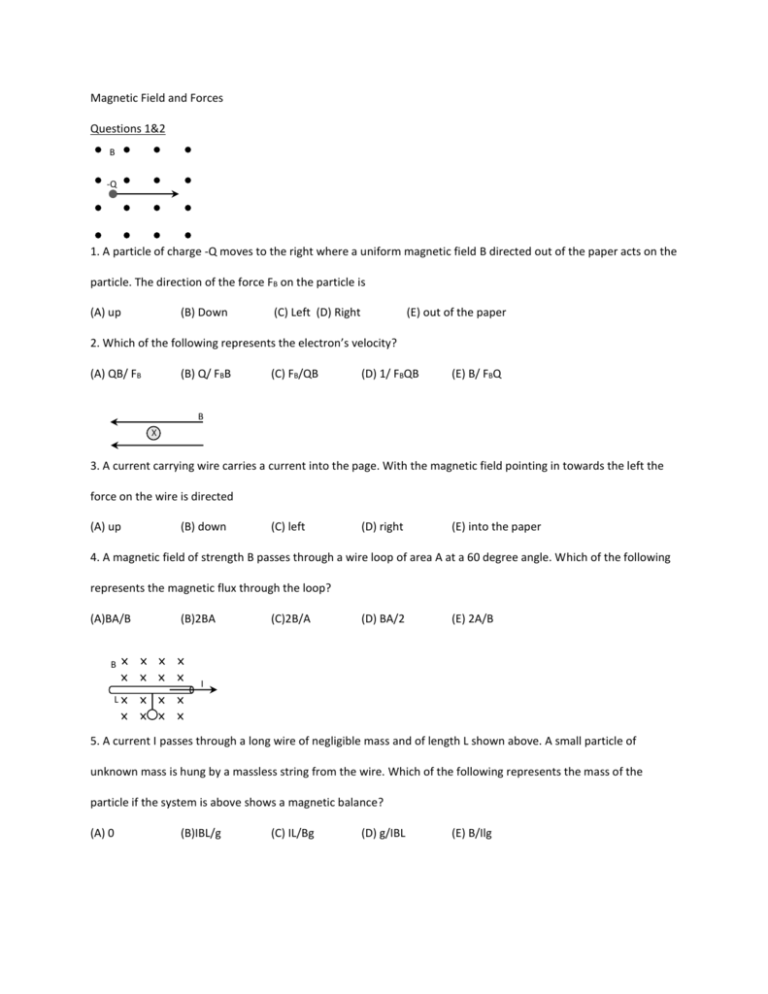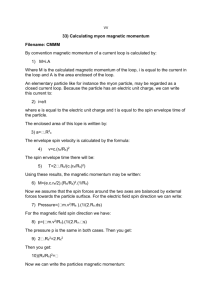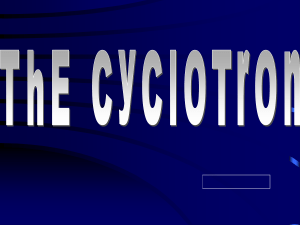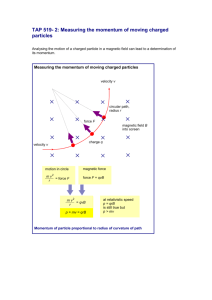Magnetic Field and Forces B -Q Questions 1&2 1. A particle of
advertisement

Magnetic Field and Forces Questions 1&2 B -Q 1. A particle of charge -Q moves to the right where a uniform magnetic field B directed out of the paper acts on the particle. The direction of the force FB on the particle is (A) up (B) Down (C) Left (D) Right (E) out of the paper 2. Which of the following represents the electron’s velocity? (A) QB/ FB (B) Q/ FBB (C) FB/QB (D) 1/ FBQB (E) B/ FBQ B X 3. A current carrying wire carries a current into the page. With the magnetic field pointing in towards the left the force on the wire is directed (A) up (B) down (C) left (D) right (E) into the paper 4. A magnetic field of strength B passes through a wire loop of area A at a 60 degree angle. Which of the following represents the magnetic flux through the loop? (A)BA/B (B)2BA (C)2B/A (D) BA/2 (E) 2A/B B I L 5. A current I passes through a long wire of negligible mass and of length L shown above. A small particle of unknown mass is hung by a massless string from the wire. Which of the following represents the mass of the particle if the system is above shows a magnetic balance? (A) 0 (B)IBL/g (C) IL/Bg (D) g/IBL (E) B/Ilg 6. In a region of space there is a uniform B field in the plane of the page but no E field. A positively charged particle with velocity v directed into the page is subject to a force F in the plane of the page as shown above. Which of the following vectors best represents the direction of B? (A) (B) (C) (D) (E) 7. A particle of charge 2x10-6 experiences a magnetic force 4x10-12 N moving at a 30 degree angle to that of a magnetic field of 4x10-3. Which of the following represents the electron’s speed? (A) 1x10-3m/s 8. (B) 3x10-3 m/s (C) 4x10-3 m/s (D) 2x103 m/s (E) 1x103 m/s A negatively charged particle in a uniform magnetic field B moves with constant speed v in a circular path of radius r, as shown above. Which of following graphs best represents the radius r as a function of the magnitude of B, if the speed v is constant? Questions 9-11 E B 9. An electron enters a plane where both a magnetic field B into the page and electric field E between the two plates act on the particle as shown above. What must be the direction of the electric field in order for the particle to move in the straight line? (A) Up (B) Down (C) Left (D) Right (E) Into the page 10. Which of the following represents the particle’s velocity when it enters the plane? (A) E/B (B) B/E (C) B2/E (C) B/√E (E) E2/B 11. If the electric field is removed which of the following represents the motion of the electron? (A) To the right (B) Parabolic path downward (C) Parabolic path upward (D) Circular path clockwise (E) Circular path counter clockwise Questions 12-13 The ends of a metal bar rest on two horizontal north-south rails as shown above. The bar may slide without friction freely with its length horizontal and lying east and west as shown above. There is a magnetic field parallel to the rails and directed north. 12. If the bar is pushed northward on the rails, the electromotive force induced in the bar as a result of the magnetic field will (A) be directed upward (B) be zero (D) produce an eastward current (C) produce a westward current (E) stop the motion of the bar 13. A battery is connected between the rails and causes the electrons in the bar to drift to the east. The resulting magnetic force on the bar is directed (A) north (B) south (C) east (D) west (E) vertically Questions 14-15 A proton traveling with speed v enters a uniform electric field of magnitude E, directed parallel to the plane of the page, as shown in the figure above. There is also a magnetic force on the proton that is in the direction opposite to that of the electric force. 14. Which of the following is a possible direction for the magnetic field? (A) (B) (D) (directed out of the page) (C) (E) (directed into the page) 15. If e represents the magnitude of the proton charge, what minimum magnitude of the magnetic field could balance the electric force on the proton? (A) E/v (B) eE/v (C) vE (D) eE (E) evE Questions 16-17 A narrow beam of protons produces a current of 1.6 x 10-3 A. There are 109 protons in each meter along the beam. 16. Of the following, which is the best estimate of the average speed of the protons in the beam? (A) 10-15 m/s (B) 10-12 m/s (C) 10-7 m/s (D) 107 m/s (E) 1012 m/s 17. Which of the following describes the lines of magnetic field in the vicinity of the beam due to the beam's current? (A) Concentric circles around the beam (B) Parallel to the beam (D) Radial and away from the beam (C) Radial and toward the beam (E) There is no magnetic field. 18. A uniform magnetic field B is parallel to the xy-plane and in the +y-direction, as shown above. A proton p initially moves with velocity v in the xy-plane at an angle to the magnetic field and the y-axis. The proton will subsequently follow what kind of path? (A) A straight-line path in the direction of v (B) A circular path in the xy-plane (C) A circular path in the yz-plane (D) A helical path with its axis parallel to the y-axis (E) A helical path with its axis parallel to the z-axis 19. A beam of protons moves parallel to the x-axis in the positive x-direction, as shown above, through a region of crossed electric and magnetic fields balanced for zero deflection of the beam. If the magnetic field is pointed in the positive y-direction, in what direction must the electric field be pointed? (A) Positive y-direction (E) Negative z-direction (B) Positive z-direction (C) Negative x-direction (D) Negative y-direction 20. A bar magnet and a wire loop carrying current I are arranged as shown above. In which direction, if any, is the force on the current loop due to the magnet? (A) Toward the magnet (B) Away from the magnet (C) Toward the top of the page (D) Toward the bottom of the page (E) There is no force on the current loop. 21. A negatively charged particle in a uniform magnetic field B moves in a circular path of radius r, as shown above. Which of the following graphs best depicts how the frequency of revolution f of the particle depends on the radius r ? y θ v z x B 22. A positive charge q with velocity in the xy plane makes an angle theta with respect to a uniform magnetic field directed along the positive y axis. The motion of the charge is best described as (A) circular motion in the xy plane (B) circular motion in the xz plane (C) uniform motion (D) helical motion with an axis parallel to the x axis (E) helical motion with an axis parallel to the y axis 23. What is the magnitude of the force acting on the charge? (A) qvb (B) qvbcosθ (C) qvb sinθ (D)qv/bsinθ (E) qvbsinθ - qvbcosθ 24. A particle with a given mass m of charge q moves with speed v to the right as shown above in a magnetic field of strength B. If the particle moves as shown what is the radius of the particle’s movement? (A) 𝑞𝑣𝐵−𝑚𝑔 𝑚𝑣 2 (B) 𝑞𝑣𝐵−𝑚𝑣 2 𝑚𝑔 (C) 𝑚𝑣 2 𝑞𝑣𝑏−𝑚𝑔 (D) 𝑚𝑞𝑏−𝑔𝑣 2 𝑣 (E) 𝑣 𝑚𝑞𝑏−𝑔𝑣 2 I v 25. A loop of wire has a current I running through it in a counter clockwise direction. An electron moving with velocity v downward is placed outside of the loop in the magnetic field created by the loop of wire. Which of the following represents the direction of the magnetic force due to the loop on the electron at this specific moment? (A)To the right (B) To the left (C) Into the page (D) Out of the page (E) To the top of the page Answers 1. A 2. C 3. A 4. D 5. B 6. E 7. A 8. B 9. B 10. A 11. D 12. B 13. E 14. D 15. A 16. D 17. A 18. D 19. E 20. A 21. A 22. E 23. C 24. C 25. B









